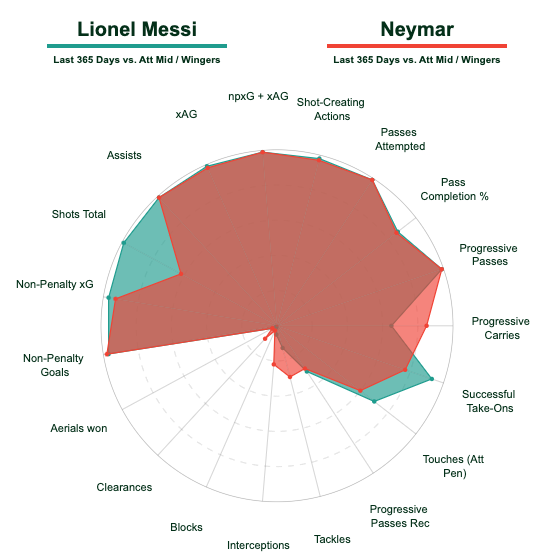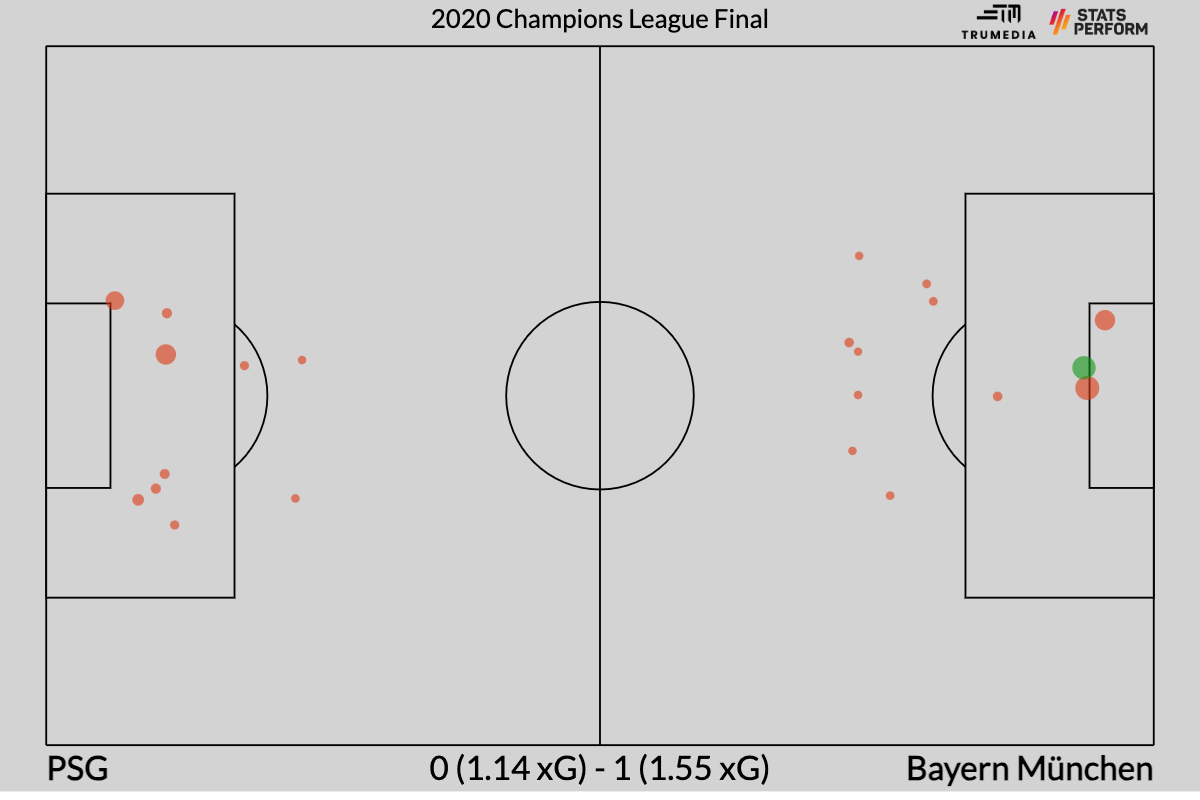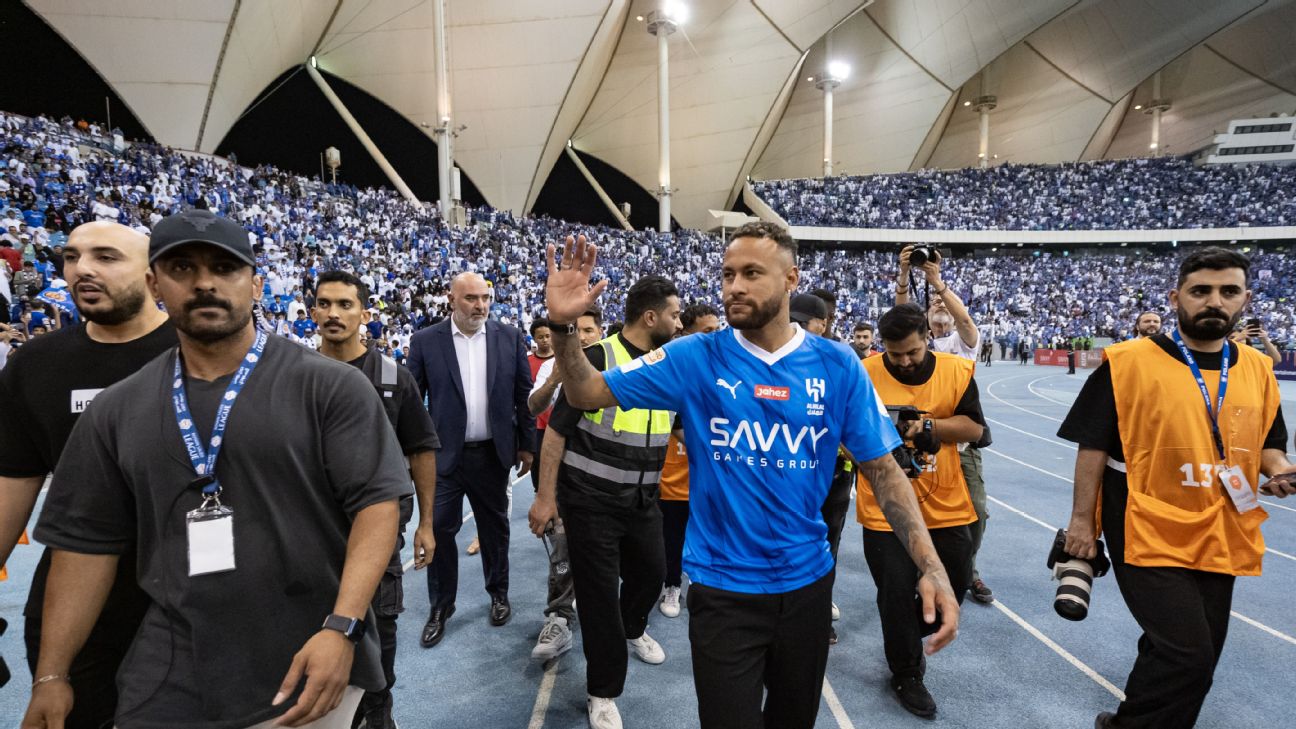A little over six years ago, the soccer world seemed like it had just changed forever. Roughly two months after masterminding maybe the greatest comeback in the history of the Champions League for Barcelona against Paris Saint-Germain, Neymar was leaving Barcelona to go play for PSG.
The fee, of course, stood out — how could it not? PSG paid €222 million to meet his buyout clause, which Barca seemingly had set at a random impossible-to-meet number during contract negotiations. After all, the previous transfer record was just — “just” — €105 million, paid by Manchester United for Paul Pogba the summer before.
After years of gradually edging upward by €5 million or €10 million or €15 million, the world-transfer record suddenly doubled overnight. The largest previous jump was from €60 million to €77.5 million — Real Madrid’s moved first for Luis Figo and then for Zinedine Zidane. That’s about a €17 million increase; PSG’s move for Neymar increased the record by … €117 million. The fact that there now existed a soccer club both capable and willing to do this meant that the fundamentals of the game had, well, fundamentally changed.
It wasn’t quite clear exactly how they had changed in the moment, but the way things had worked in the past was that the best players in the world would all eventually make their way to Barcelona or Real Madrid. Sometimes there wasn’t enough room for all of them, and obviously not every superstar wanted to live in Spain, but this was broadly the way of the soccer world.
In Neymar, Barcelona had acquired the next-best player in the world to go along with the current best player in the world, Lionel Messi. He arrived in Catalonia at 21, won the Champions League at 23 and figured to be there for the rest of his prime. And then, at 25, he was gone. Superstars just didn’t do that to Barcelona or Real Madrid. We had entered a new world.
Or had we? Six years on from maybe the most shocking individual player transaction of all time, with Neymar leaving Ligue 1 for the Saudi Pro League, it doesn’t really seem like it’s worked out for anyone involved.
Neymar
After agreeing to a deal with Saudi club Al Hilal, Neymar’s relevance at the top level of global soccer is over. I’m sorry, but that’s just how this works. You get to take the money; you don’t get to act like you’re still pursuing any kind of athletic excellence.
As someone who quite enjoys watching Neymar play soccer, I find it kind of sad. I’ve never seen anyone move like him. Soccer is supposed to look hard: You’re dribbling a ball with your feet, and there are only so many body positions you can get into that allow you to control it with any sort of confidence. You perfect the fundamentals as a kid, and then you build off that base. At least, for most people. For Neymar, it didn’t matter that the ball was round and your foot was a weird, bony misshapen thing with toes and your knees bent only forward and backward and your hips could open by 90 degrees.
– Stream on ESPN+: LaLiga, Bundesliga, more (U.S.)
In terms of the pure skill of controlling a soccer ball through a variety of circumstances and move it toward the opposition goal, Neymar is the best there ever was.
That goal, though, sort of symbolizes his career. It was an incredible run and an incredible finish; it’s all him, as he’s the only one who can do that. With just a few minutes left in extra time of a World Cup quarterfinal, it should have gone down as one of the best goals in the history of the tournament. It should have set up an epic semifinal with Messi and Brazil’s eternal rivals Argentina. It should have; instead, Croatia soon equalized on a lucky deflection with barely any time left and then won on penalties.
That goal happened; we all saw it, feeling its importance as it happened. That was real — and then everything that happened since made it feel fake. Not unlike the path Neymar walked over his 10 years in Europe.
There’s no use in contextualizing what happened at Barcelona; he was brilliant, full stop. The 2014-15 team might be the best club side of all time, and the 2015-16 team was right up there, too. In his three years as a full-time starter with the club, he averaged 20 goals and 11 assists per LaLiga season. And he played a little over 80% of the available league minutes.
Whenever the club needed him, he was there — over and over and over again. During the last two seasons, in particular, he picked up the slack whenever Messi was injured or had a rare off day.
That comeback happened in 2017, he was 25, and it might have been his last high-level triumph in Europe. When you move to PSG, you’re accepting that you’re only going to get a couple of chances to play games that really matter. Your team have so much more money than the rest of the league that they’re going to win Ligue 1 whether or not you’re there. But Neymar pushed that idea about as far as he could. While in Paris, he appeared in a comical 48% of the league minutes. PSG doubled the transfer record for a player who wasn’t even out there half of the time.
Of course, they didn’t really care about that. But over his final three seasons at Barca, Neymar played in 89% of the possible Champions League minutes. Despite easing off the gas pedal in Ligue 1, his European participation for PSG also declined to 71% of available CL minutes.
So we’re just left with this kind of incredible, unsatisfying half-formed career. On the one hand, Neymar was the most-hyped prospect since Messi, he moved to Barcelona at 21, almost immediately lit the league on fire, exceeded all of the near-impossible expectations and won every possible trophy in sight.
From a pure per-minute production standpoint, he’s the closest thing we’ve seen to the greatest to ever do it:

(Image courtesy of FBcharts.com/Opta)
On the other hand, well, Neymar might be better at the pure act of playing soccer — manipulating the ball with anything other than your hands than anyone else has been. But for the entire second half of his 20s, we rarely got to see him play.
Paris Saint-Germain
PSG acquired Neymar to help them win the Champions League. With him at the club, they reached one final — albeit in the COVID-abbreviated, single-elimination season — and one semifinal, but otherwise never made it past the round of 16. They’d reached the quarterfinals in all four seasons before Neymar arrived.
That’s not to say the team’s failure is Neymar’s fault. Rather, when your only goal is to win an incredibly random knockout soccer competition, perhaps it’s not wise to invest that much money in a single player — even when you have comparatively unlimited funds compared to your competitors. Although, had they won the final against Bayern Munich in 2020, then maybe this whole section would be moot. Had a couple of bounces gone differently, they would’ve won that game, too:

However, more broadly, PSG seemed poised to take over European soccer in the summer of 2017. Don’t forget they also signed Kylian Mbappé for what would’ve been a pre-Neymar world-record fee that offseason, too. They had their Jordán-brand jerseys. They were in freaking Paris, after all.
Was this going to become the new team that all the young superstars wanted to go to? Could they continue to poach away ready-made excellence from the Barcelonas and the Real Madrids of the world?
Not really, no.
Although club chairman Nasser Al-Khelaifi has steadily accrued more power within the bureaucracy of the European game and although they were also able to employ Lionel Messi while he finally won that elusive World Cup with Argentina, PSG’s standing within the sport might be lower than it was before they brought in Neymar. They’re on their fifth coach in the previous six years, and there’s some kind of pathetic, massive blowup every time they get eliminated from the Champions League. It’s always someone else’s fault.
And while it seems like Mbappe, who has only a year left on his contract, is going to stay with the club, I can’t imagine the whole “sign a new contract or we bench you” thing is going to endear them to the next generation of stars, either.
In 2023-24, it does seem like they’re finally trying to build something resembling a real team for the first time — surrounding Mbappe with a bunch of complementary pieces who can cover up all the gaps created by having a player who doesn’t do much defending and who needs players to pass him the ball. But they’re still a ways away from achieving the one thing they want to achieve.
As of now, five other teams (Manchester City, Bayern Munich, Real Madrid, Arsenal, and Barcelona) have better odds to win this season’s Champions League. They’re closer to Manchester United in seventh than they are to Manchester City in first.
Barcelona
In the two years after Neymar left, Barcelona won consecutive league titles, but paired that with two massive Champions League second-leg collapses — first against Roma and then against Liverpool. They didn’t win another league title until last year. Oh, and they lost Messi and have since progressively sold off large chunks of their future revenues in order to fund transfer purchases to improve the current squad in the short term.
For now, at least, Barcelona are no longer the go-to destination for the best young stars in the sport. That’s either Real Madrid or Manchester City — one club are their hated rivals, the other are now being run by all of the people who helped build the great Barcelona sides of the late aughts and early 2010s.
When they lost Neymar, Barcelona were still at the top of European soccer right along with Madrid, and maybe Bayern Munich and Juventus. They weren’t expecting to lose Neymar, but suddenly they had $200 million-plus to acquire pretty much anyone they wanted. Messi, Suarez and most of the 2014-15 core were still there. Given that no player had ever gone for even half as much money as Neymar did, it stood to reason that the income could be reinvested in a group of players who could provide more value to the club collectively than Neymar could on his own.
They kind of tried to do that, but really they just tried to acquire two Neymars, 20-year-old Ousmane Dembélé from Borussia Dortmund (€105 million) and 25-year-old Philippe Coutinho from Liverpool (€145m). Among similar-to-Neymar players — guys who could score and create goals while also moving the ball up the field — these were probably the two best 25-and-under options available. Rather than spreading the risk around, Barca went all-in on two players who could max out Messi’s 30s and carry the torch after he left the club.
Except, they swung and missed on both.
A ball-dominant midfielder/attacker, Coutinho proved to be too similar to Messi, either crowding out the best player of all time or not providing the kind of off-ball movement necessary to take advantage of Messi’s skills. He played only 32% of the minutes while with the club and was sent out on loan after just his first full season in Spain.
The speedy Dembele, meanwhile, was the perfect player to pair with Messi and add to an aging, increasingly unathletic Barca side — in theory. It’s just that he, too, never played. In his six seasons with the club, he featured in just 37% of all the domestic minutes. Rather than a performance issue, like Coutinho, Dembele’s main problem is that he was simply never healthy, though the outcome was essentially the same.
In reality, the only team that really seemed to materially benefit from the Neymar transfer — and have their trajectory changed in a clear and meaningful way — were Liverpool.
After letting Coutinho go to Barcelona in the middle of the 2017-18 season, they first acquired center-back Virgil van Dijk from Southampton and promptly made a run all the way to the Champions League final. After losing to Real Madrid, 3-1, they acquired defensive midfielder Fabinho from Monaco and keeper Alisson from Roma, both moves no doubt aided by the influx of cash from the Coutinho transfer. With all three of those players starting, Liverpool beat Barcelona in the semifinals of the following season’s Champions League before taking down Tottenham in the final.
That trio formed the spine of a team that would go on to win every trophy possible over the following four seasons. Who knows if that still happens if Coutinho stays at Anfield?
Neymar, meanwhile, made a ton of money in a career that isn’t going to last for long, so he didn’t really “lose,” either. But I think he’d sit higher in the public estimation had he remained at Barcelona because I think Barcelona would have been better off, too, had he stayed. The mismanagement of the club had already begun before he left, but given how good Neymar was in Spain — and how not-present Coutinho and Dembele ended up being — he likely would have raised the team’s performance to a higher level than what we saw in the seasons following his departure.
With PSG, I’m not so sure that they wouldn’t have just signed another Neymar-esque player had they failed to sign Neymar back in 2017. Chase the big name, regardless of the fit. Their overall track record doesn’t suggest that they would’ve found someone better, and the team really were quite good at times with Neymar and Mbappe together in the Champions League. The bigger issue was with how they built the team around those two.
But maybe, if Neymar doesn’t come, the club quickly realize that Mbappe might be an even bigger star and better player — and then they focus on building the team around his strengths and weaknesses. I doubt it, but we can’t know for sure.
Instead, though, we’re left with a process that might as well have never happened. Neither Barcelona nor PSG won another Champions League, and they reached only one final, combined. At just 31, Neymar is already off to wind down his career in Saudi Arabia. Coutinho is coming off the bench for Neymar’s first PSG manager, Unai Emery, now at Aston Villa in the Premier League.
And perhaps most fittingly of all, Dembele, the player whom Barcelona first signed to replace Neymar, now plays for PSG.



